100% New Mexico Initiative
100% POWER HOUR
ONE: ASSESSING THE NEED FOR CHANGE
PLEASE NOTE: This page contains supplemental information for attendees of the 4-part 100% New Mexico initiative power hours. Attendance is free, but registration is required. Please register here.
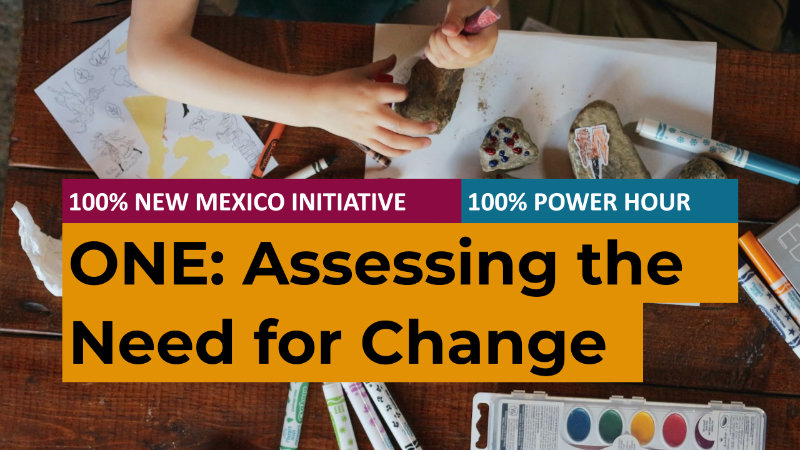
We are providing the slides and narrative text used in the 100% Power Hour: Assessing the Need for Change being offered quarterly by the Anna, Age Eight Institute. The 4-part webinar series is designed to give 100% New Mexico initiative members an overview of key concepts and issues related to implementing the initiative in their county.
Power Hour participants are encouraged to use this presentation page for local presentations in order to increase public awareness of adverse childhood experiences (ACEs), trauma, social adversity, and the data-driven prevention strategies shown to transform the adverse social determinants of health into positive ones by ensuring ten vital services.

Before we begin our presentation, we want to allow for a moment of quiet reflection. Please take a minute to perform the self-care of your choice.
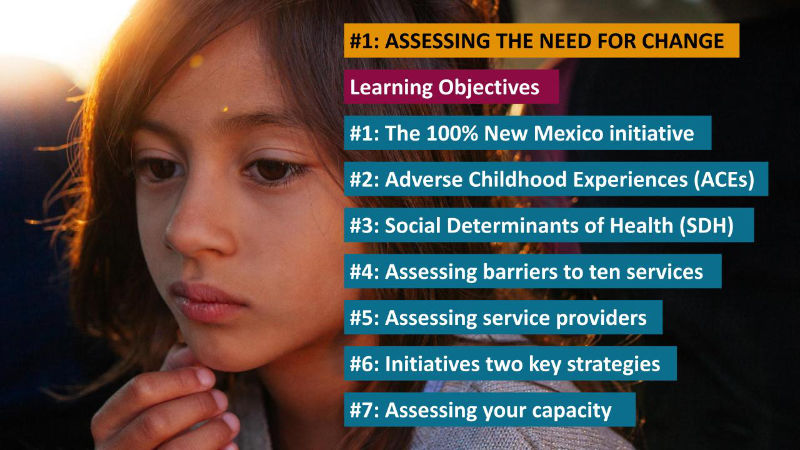
The learning objectives of 100% Power Hour #1: Assessing the Need for Change participants completing the webinar will be able to describe an overview of: adverse childhood experiences (ACEs), the social determinants of health (SDH), the definition of assessment, the countywide survey process assessing barriers to vital services, the initiative’s two key strategies, and assessing local service provider’s capacity to meet the needs of families.
.

The 100% Power Hour 4-part webinar series was developed to provide initiative participants with an overview of key concepts that guide the initiative. This includes the detailed initiative programming to empower local county and city stakeholders as they address challenges through the process of continuous quality improvement: assess, plan, act, and evaluate. In this presentation we focus on the assessment process.

PART ONE: HOW DO WE KNOW WHAT CHALLENGES EXIST?
The 100% New Mexico initiative, like many health initiatives across the country, seeks to prevent the costly challenges that diminish the lives of children, youth, and adults. We don’t lack data that documents our health challenges. Every state department of health provides data on the incidence of illness, injury, and violence, along with reports that detail our student’s troubling experiences with challenges outside the home.
We don’t lack data to illustrate how many of our communities are at risk for ongoing substance use disorders, domestic violence, untreated mental health challenges, and joblessness. For decades, data have informed us yet failed to move us to action. Until now.
We are united in ensuring that 100% of county residents can access the ten vital services for surviving and thriving. This presentation will provide an overview on the challenges we seek to prevent, including adverse childhood experiences (ACEs) and the adverse social determinants of health.

The 100% New Mexico initiative is the centerpiece of the Anna, Age Eight Institute’s programming. It was developed by institute co-directors Dr. Katherine Ortega Courtney and Dominic Cappello who are the co-authors of Anna, Age Eight and 100% Community.
Anna, Age Eight: The data-driven prevention of childhood trauma and maltreatment guides communities in addressing epidemic rates of adverse childhood experiences (ACEs) that occur in the home and social adversity that families face outside their front door.
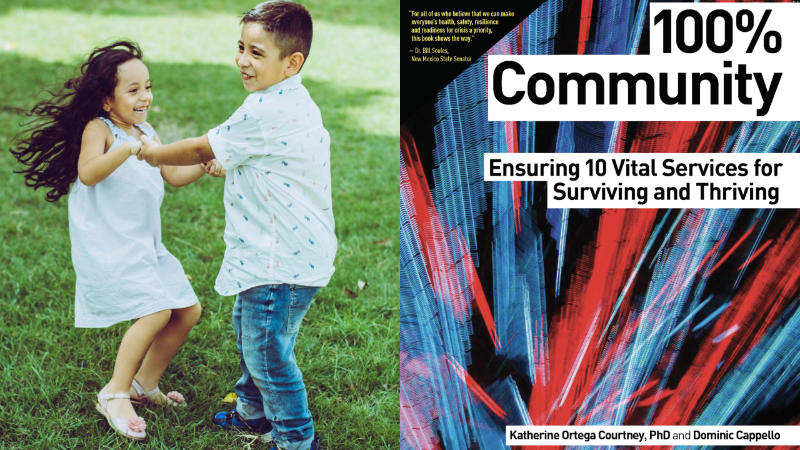
100% Community: Ensuring 10 vital services for surviving and thriving is the blueprint that 100% New Mexico initiative participants are using to assess barriers to vital services and build a countywide system of care that includes timely access to vital services. The book details how we collaborate to build the services in each county.
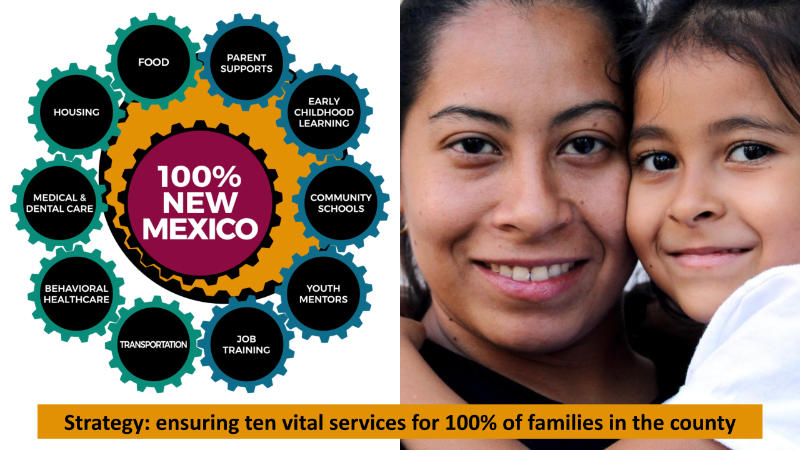
The social determinants of health are the services available to residents in their community environment. There are many definitions of the social determinants of health. Within our initiative, the social determinants of health are represented by ten vital services for surviving and thriving. The determinants may be adverse, meaning lack of services. Positive determinants mean a community with timely access to ten services.
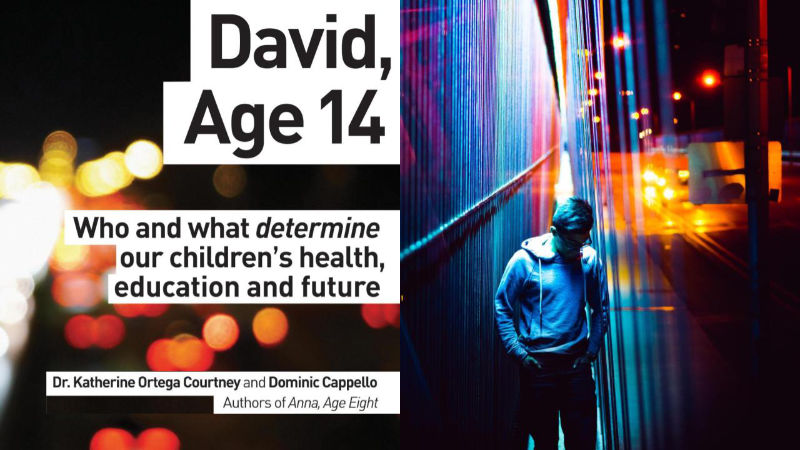
You can learn more about the social determinants of health in the book David, Age 14. This book describes the impact of the lack of services on the health, education, and overall quality of life of David and his family. The experience of David is impacting many families across New Mexico, leading to our most costly public health and education challenges.
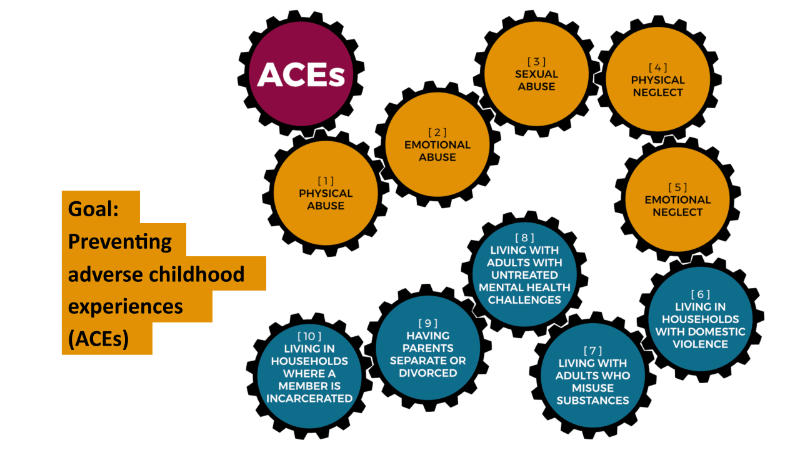
ACEs are ten forms of adversity, abuse, and neglect children endure in the home. Our goal is to identify the root causes of adverse childhood experiences and work to prevent the ten forms of adversity that include abuse, neglect, and living in homes where adults have substance use disorders, engage in violence, and have untreated mental health challenges. ACEs can diminish a child’s life in many ways, including their capacity to learn in school, become job ready, maintain steady employment, and cope with traumatic feelings without self-medicating.
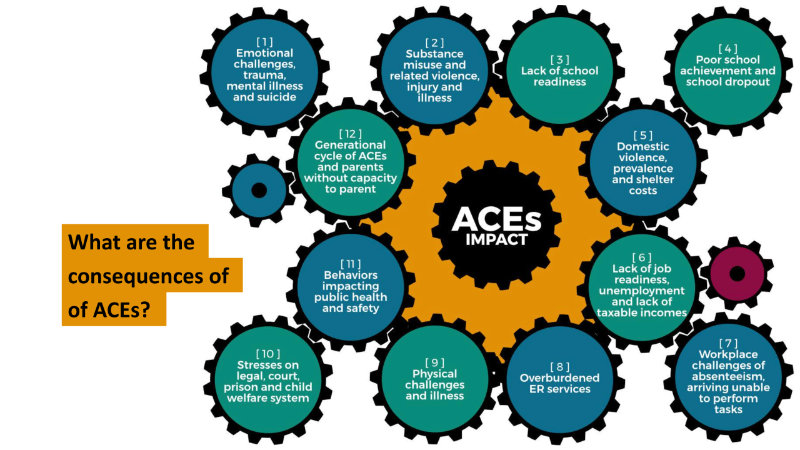
ACEs and the potential trauma they can cause are far from a “private family matter.” The physical, emotional, and economic consequences are significant and impact entire communities, as well as city, county, and state budgets. ACEs lead to costly interventions (including law enforcement, child welfare, the courts, and ER services), all with financial costs to taxpayers.

We are also focusing our 100% New Mexico initiative within each county on ending the social adversity our children, students, parents, and caregiving grandparents are facing.
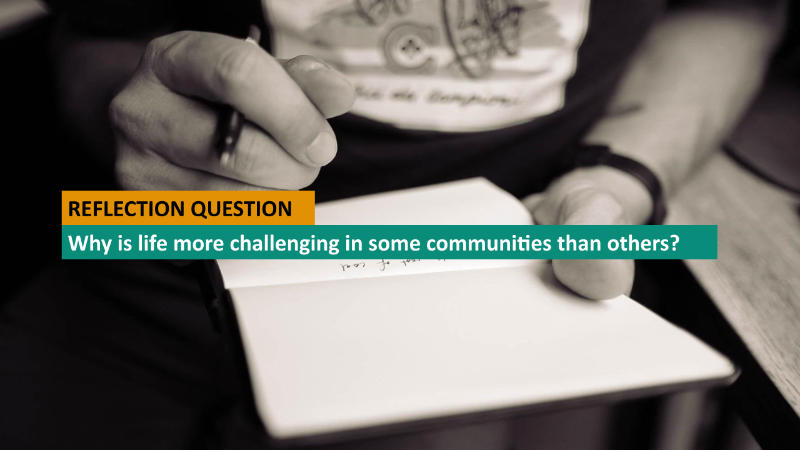
REFLECTION QUESTION: Before moving on, take a few moments to reflect on why life is more challenging in some communities than others.

PART TWO: WHAT CAN ASSESSMENT TELL YOU AND YOUR LEADERS?
There are important questions to ask, within the context of the 100% New Mexico initiative. A simple one is, “To what degree do county residents endure health, safety and economic challenges?” Public health leaders would phrase this question as, “What percentage of families are living in community environments that represent the adverse social determinants of health?”
The assessment process starts with the 100% New Mexico County Survey. It is one of many assessments.
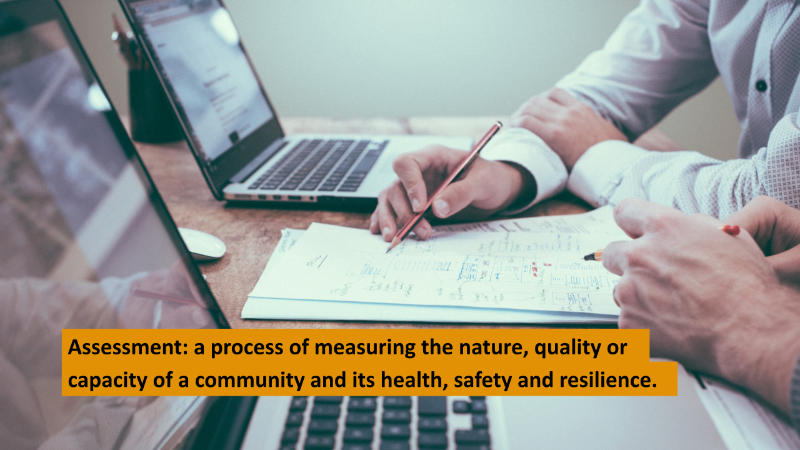
Part Two begins with a definition of assessment: A process of measuring the nature, quality, or capacity of a community and its health, safety, and resilience. In the context of our initiative, the assessment reveals the challenges and the local capacity to address those challenges in a timely, measurable, and meaningful process.

The 100% New Mexico initiative is guided on the county level by the four-phase process of continuous quality improvement. The phases are assessment, planning, action, and evaluation. Assessment is the first phase and the data gathered provides valuable information about both residents and service providers.

The 100% New Mexico County Survey starts with simple questions about a resident’s access to the ten vital services for surviving and thriving. We are seeking to understand the need for services and the challenges accessing them.
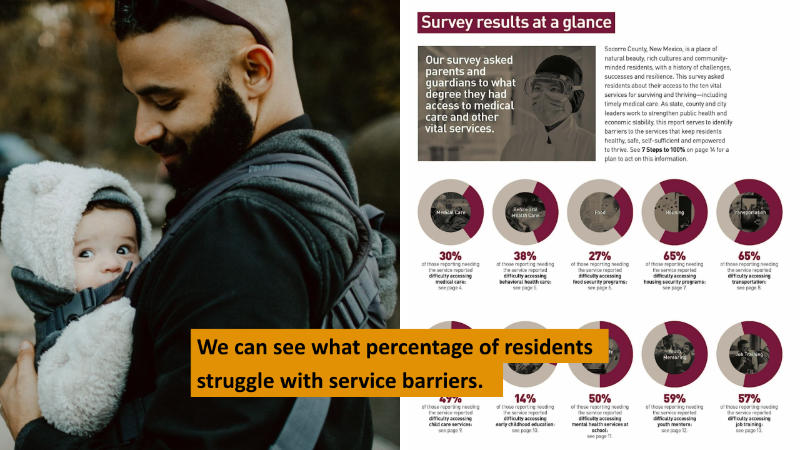
With a completed countywide survey, the county-based 100% New Mexico initiative members will be able to analyze data. This analysis is done in the ten action teams, each one focused on one service area. Through this process, the entire initiative membership develops a shared understanding of how the ten interrelated services may be unreachable to some residents.

100% New Mexico action teams meet throughout the month as they review each barrier. We know that barriers can include cost, lack of transportation to services, unfriendly hours, inability to qualify, or languages spoken by the providers. Lack of access to the internet may also be a barrier when seeking services.
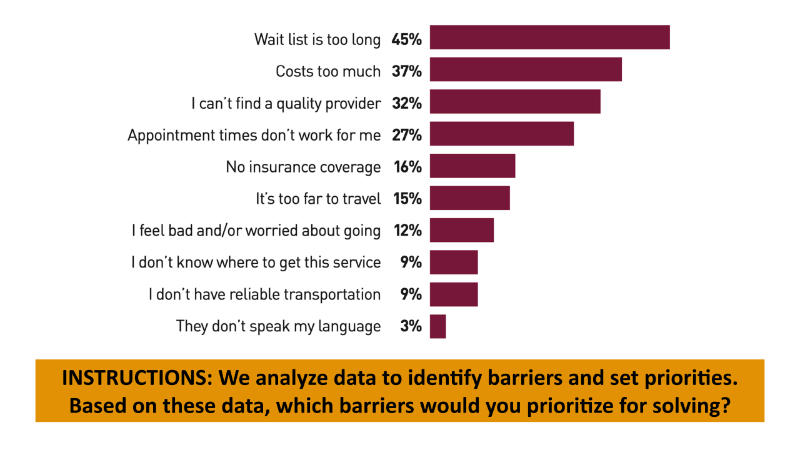
INSTRUCTION: Please review the barriers, noting how you would prioritize in your county and why.
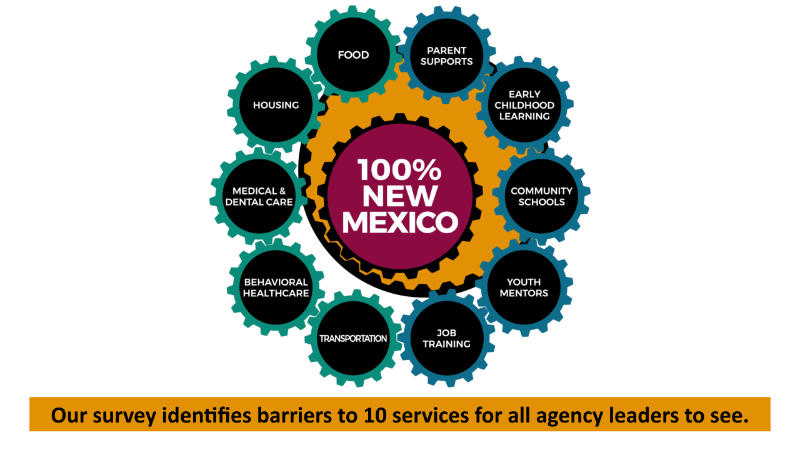
Our survey reports are meant to be shared with every mayor, city councilor, county commissioner, school board member, and state lawmakers representing your county. These data are the catalyst for ongoing conversations with local leaders about the magnitude of service barriers. Additional public health data reveal the challenges local residents are facing, which include child abuse and neglect, substance use disorder-related illness, injury and fatalities, and untreated medical and mental health challenges.

REFLECTION QUESTION: Why have our challenges not been addressed yet?

PART THREE: HOW PARENT-FRIENDLY ARE SERVICES?
Our work in the assessment process is for each of the ten action teams to connect with service providers in their area. The goal is to conduct informational interviews to understand the capacity of each organization to provide services, as well as connect and align with other service providers offering similar services in the county.

Initiative action teams can create a weekly schedule of services. For example, in one county the food action team identified all the hours of food security programs, including food pantries and those providing commodities. If one were a working mom with two preschoolers, which services could she easily access during the week?
Each action team will gain valuable insights about how user-friendly a service is for different populations. We need to consider that some parents work full-time and can’t access services during the workday. Some parents work the night shift (or two shifts), and some can be car-free. With this understanding, action teams can work with all service providers to align service hours and meet the needs of families seven days a week.
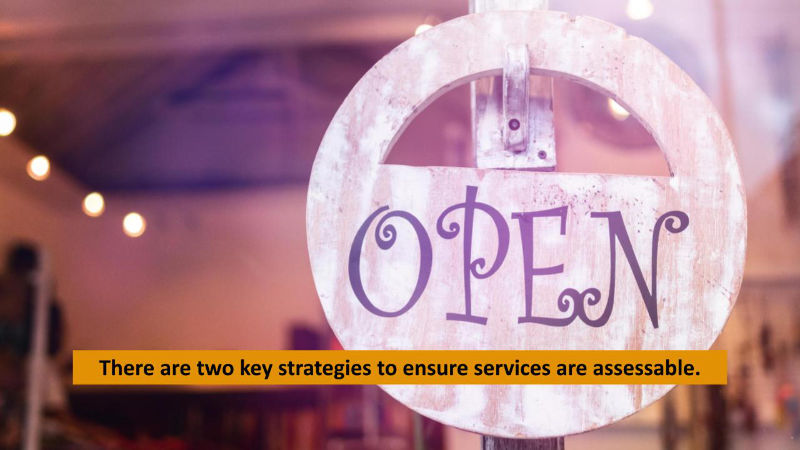
There are two key strategies to ensure that ten vital services can meet the needs of 100% of families who reside within the county’s borders. These are strategies that our county and city governments can help support.

Strategy One – The 100% Family Center: One-Stop Service Hub
With this strategy, ten action teams work together to bring all services to one location in the most populous city in the county. For a working parent with two preschoolers, this means one visit meets many needs. The transportation action team can review all public transportation options within the county, assessing how residents in communities scattered across the county can access transportation to a main service hub.
In the assessment process, service providers can be interviewed about their interest in being part of a service hub.

Strategy Two – 100% Community School: Every School Becomes a Service Hub
With this strategy, ten action teams work together to bring all services to one location in each school. This is already done, to varying degrees, with the community school model in some parts of New Mexico. There is no easier place for students and their families to access services than the school.
In the assessment process, school leaders can be interviewed about their interest in becoming a fully-resourced community school with the capacity to provide all vital services for surviving and thriving.

REFLECTION QUESTION: Which of these two strategies might be the easiest to start within your county?
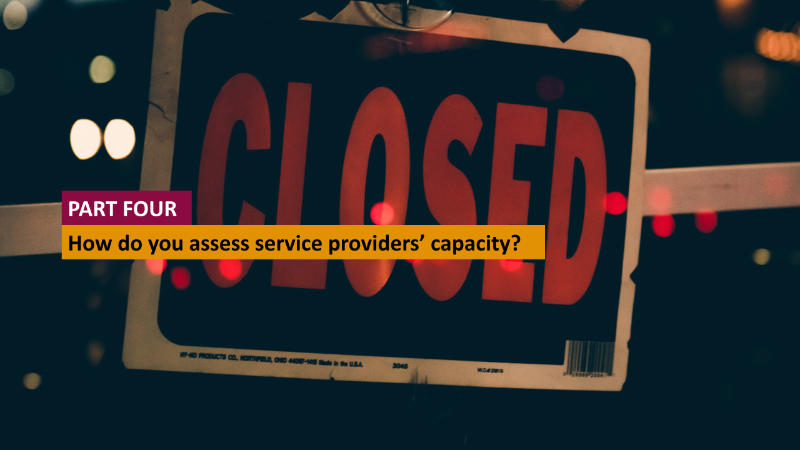
PART FOUR: HOW DO YOU ASSESS PROVIDERS’ CAPACITY?
Our assessment process provides valuable information about all the service providers in our ten surviving and thriving service areas. We are seeking to strengthen relationships with all providers and support them in meeting the needs of residents.

The assessment process with service providers is also an invitation to join the initiative and form strong partnerships. Assessment can be viewed as intrusive by some providers. We seek to have a respectful and thoughtful process seen as one of identifying challenges leading to innovation, and empowerment of all families.
By doing an assessment of organizations providing ten services, you will have all the information you require to update your local service directories and create a 100% New Mexico Family Services Directory.

REFLECTION QUESTION: Who in your county has experience with the assessment process?

NEXT STEPS: Reflect on the presentation and your notes. Review the books and links to the research provided. Reach out to colleagues, friends, family, neighbors, and local elected leaders to discuss the 100% New Mexico initiative. We have designed this presentation so that it can be used with local elected officials within city and county government and school board members, agency leaders (representing the ten vital services), representatives from local higher education, faith and community-based organizations, and your neighbors and friends.

Visit the 100% New Mexico website to access local 100% New Mexico sites across the state, research, data, podcasts, our blog, and frameworks.
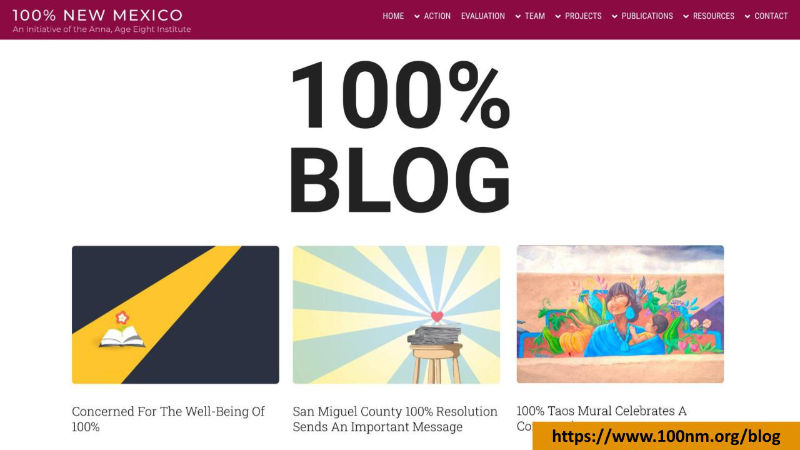
Subscribe to our 100% Blog with articles on challenges, opportunities, and local successes with county initiatives.
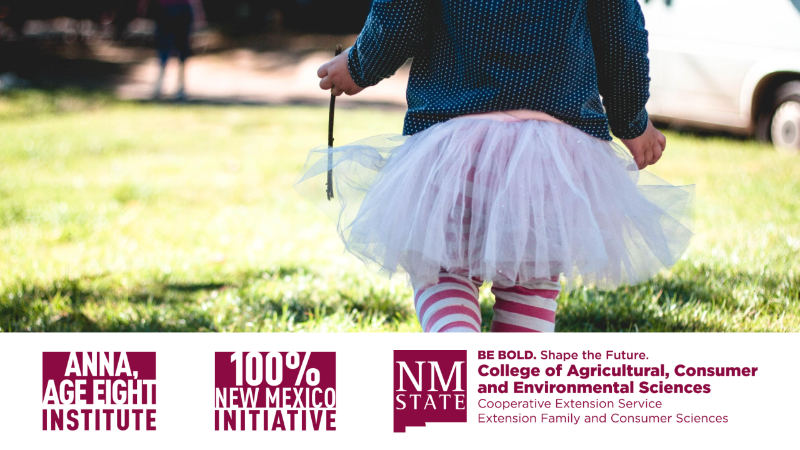
The next 100% Power Hour is Planning for Change. We hope to see you there. For any questions about the 4-part webinar series, the initiative, research guiding the process or practical steps in starting the initiative, please contact us annaageeight@nmsu.edu.
Additional Resources
Research
Explore Our Research Pages

